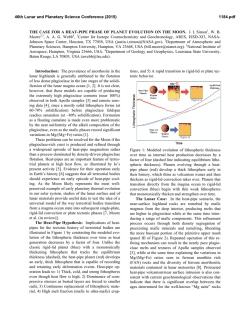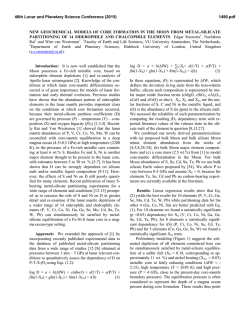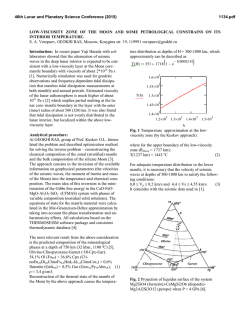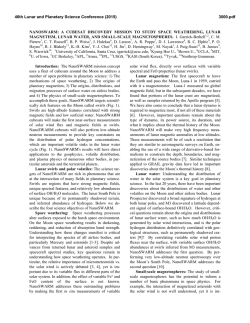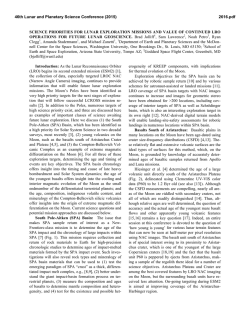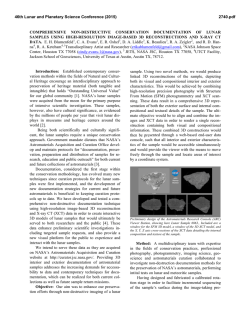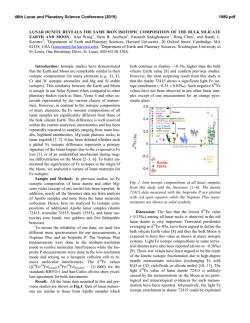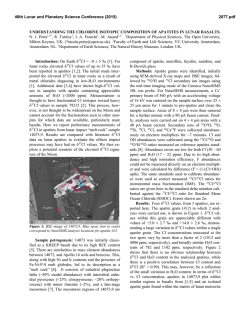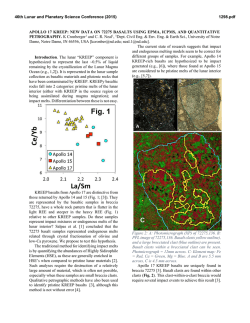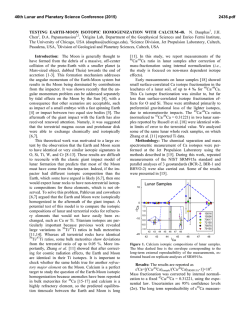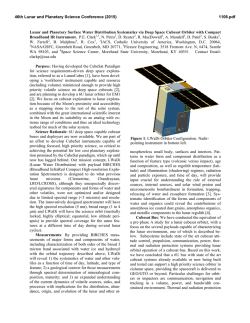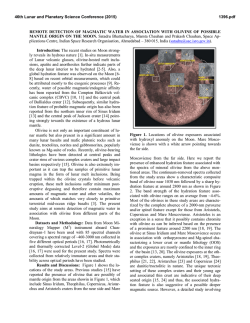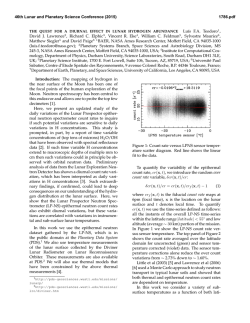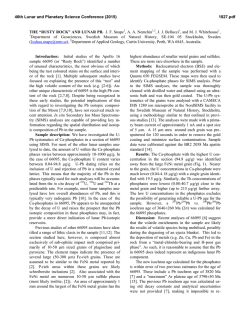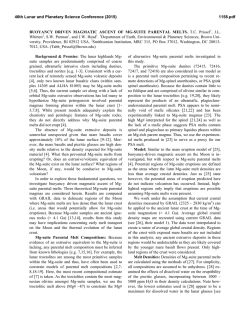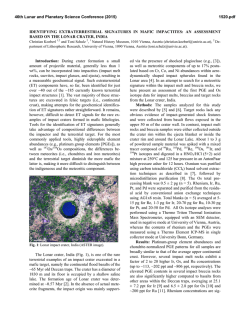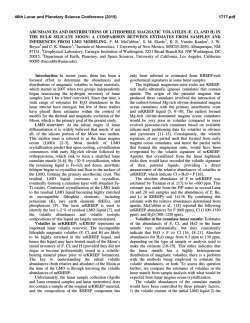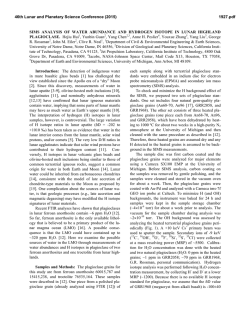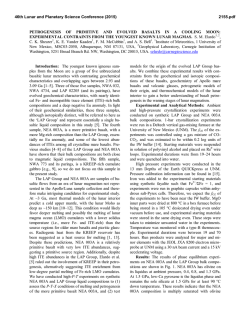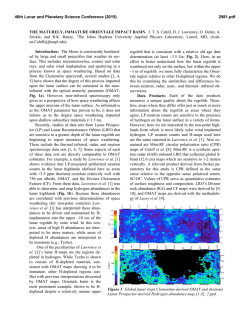
Radically Heterogeneous Distribution of Volatiles in the Moon
46th Lunar and Planetary Science Conference (2015) 2815.pdf RADICALLY HETEROGENEOUS DISTRIBUTION OF VOLATILES IN THE MOON. G. J. Taylor1 and K. L. Robinson1, 1Hawaii Inst. of Geophys. and Planetology, SOEST, U. Hawaii, 1680 East-West Rd., Honolulu, HI 96822; [email protected]. Introduction: We have known for decades that lunar mare basalts, KREEP basalts, and pristine highland rocks are strongly depleted in moderately volatile (e.g., alkalis) and highly volatile (e.g., Bi, Cd, Tl) elements (see [1] for an early summary). A major anomaly to this lunar geochemical feature are the pyroclastic deposits, such as the orange glass at Apollo 17 and the green glass at Apollo 15. A thought-provoking paper by Hauri et al. [2] draws attention to this dichotomy, adding constraints from H2O and isotopic data. Hauri et al. [2] argue that the mare basalts lost volatiles upon eruption and during protracted cooling because of the lack of an atmosphere on the Moon. The pyroclastic glasses also lost volatiles from the interiors of quenching lava droplets, but retained much of them as surface coatings. This leads to the interesting conclusion [2] that the Moon has volatile concentrations similar to that of Earth (specifically depleted MORBs), with profound consequences to our understanding of lunar formation and early bombardment. The idea that lunar lava flows lost volatiles [3] was abandoned long ago [1] based largely on the presence of normal zoning in plagioclase, which suggests that Na loss was minimal. We summarize here the distinctive geochemical differences between pyroclastic glasses and intrusive and extrusive basaltic rocks, and argue that the impressive differences in the abundances of volatile elements in them reflects huge differences in the volatile abundances of the lunar interior. Highly Volatile Elements: Fig. 1 shows the good correlation between the highly volatile element Tl and the refractory element La. Both are highly incompatible in major minerals, and only fractionate from one another in extreme petrologic circumstances. These data are compared to the orange and green glasses, MidOcean Ridge Basalts (MORBs), and Martian lava flows. The MORB data base [4] consists of 616 glass samples from mid-ocean ridges and include depleted, normal, and enriched MORBs.The slopes of the lunar basalt and MORBs differ by a factor of 67±12 (2-σ). These strikingly different slopes for mare and KREEP basalts compared to the pyroclastic deposits and Earth reflects fundamental differences between the interior source regions for these two suites of materials, unless the lunar basalts have lost significant Tl. Such loss would not be constant (e.g., lava flows always lose 98% of their volatiles) because flows vary in emplacement mechanism and duration, and in total thickness. Differential loss would be expected to lead to even more scatter than seen in the data (Fig. 1). Data for impact melt breccias, a sampling of the bulk crust, are consistent with the basalt data (Fig. 1). A recent analysis [5] of the bulk Moon composition indicates that the Moon contains only ~1% of the concentrations of highly volatile elements as Earth. Fig. 1. Tl vs La concentrations indicate two distinctive reservoirs in the Moon [15-19]. The orange/green glass source is similar to MORBs [4] and Mars [20]. Moderately Volatile Elements: Alkali elements correlate strongly with refractory incompatible elements, as shown in Fig. 2. The slopes of the two lines in Fig. 2 suggest that the Moon is depleted in alkali elements by a factor of 5 relative to Earth. More thorough analysis using bulk Moon [5] and Earth [6] suggests that alkalis are present in the Moon at 0.25 x Earth. Fig. 2. Alkali elements, such as K shown here, correlate with refractory incompatible elements in both Moon [24] and Earth [4]. Note that the orange glass plots within the lunar distribution, though on the high-K side. This is consistent with loss of K from a magma containing significantly higher K and other alkalis, perhaps even Earthlike. Indeed, the green glass seems to straddle the two 46th Lunar and Planetary Science Conference (2015) trends in Fig. 2. Nevertheless, the K/La data for the mare and KREEP basalts form a distribution that clearly distinguishes it from MORBs. When averaged, K/La is 75 for the Moon and 360 for Earth. The higher K/La in orange (115) and especially green (140) glass suggest a kinship with Earth, but still are clearly lower than in Earth. H2O and D/H: Hauri et al. [2] show that the preeruptive orange and green glasses have H2O/Ce ratios (77) similar to those in depleted MORB sources (168), consistent with their Tl/La (Fig. 1). Total H2O concentrations in basalt magmas cannot be determined quantitatively from H in apatite [7], but we estimated the preeruptive H2O content of glassy KREEP basalt fragments in breccia 15358. The glass makes up ~20% of the rock and contains 60 to 95 ppm H2O [8], implying a magma content of 12 to 19 ppm. Loss of H is likely as δD averages +730. If the initial δD was earthlike (62.5 [9]), then losing 90% of the initial H as molecular hydrogen (and deuterium) would cause the δD to rise from -62.5 to 732. This implies an initial H2O abundance of ≤160 ppm, or a H2O/Ce of 0.9 (using an average KREEP basalt Ce concentration of 185 ppm). This implies a lunar concentration of ~1% of Earth for the mare and KREEP basalts. The variation in δD of lunar samples (even apatite is useful for this purpose) is shown in Fig. 4, divided into intrusive rocks (minimal loss [10]) and extrusive rocks. Melt inclusions in olivine phenocrysts in volcanic orange glass were included in the intrusive category as they reflect trapping at high P where H2O has a high solubility. Each rock is represented by the lowest measured δD, hence minimizing fractionation of the H isotopes. The extrusive rocks, which certainly lost H when they erupted, have systematically high δD compared to the intrusive rocks, reflecting H loss, but there is considerable overlap; extrusive rocks probably had lower δD before they erupted [11]. The intrusive rocks have δD ranging from those like carbonaceous chondrites [12], 100-300, to considerably below terrestrial ratios, down to < -700. Distinctive Reservoirs: Assuming that volatile loss from mare basalts is not significant except for H2O, the data show that the Moon contains two distinct geochemical reservoirs, one with earthlike volatile abundances, including water. The specific comparison [2] is with depleted MORBs, the driest mantle-derived rocks on Earth. The range in δD is large and suggests variation in the source of water to these reservoirs, but not in any simple way such as earthlike volatile abundances equating with earthlike δD: some volatile-depleted basalts have earthlike δD. The low δD group hints that one source might be similar to the protosolar disk, -865 2815.pdf [13], while the other end member might be carbonaceous chondrites [2,12]. One interpretation is that the Moon formed sequentially from primitive, volatilepoor terrestrial materials with low δD, perhaps from adsorbed H2O from the disk [14] followed by addition of volatiles, which Hauri et al [2] argue must have occurred before formation of a substantial amount of lunar crust. Fig. 4. Variation of δD in intrusive and extrusive lunar rocks, corrected for cosmic ray production of D. Extrusive rocks tend to have higher δD than do intrusive rocks. Data from compilation in [10] and [11,21-23]. References: [1] Taylor, S.R. (1975) Lunar Science: A Post-Apollo View. [2] Hauri, E. et al. (2015) EPSL 409, 252-264. [3] O’Hara, M. et al. (1097) PLSC 1, 695. [4] Jenner, F.E. and O’Neil, H. St. C. (2012) G3 13, doi:10.1029/2011GC004009 [5] Taylor, G.J. and Wieczorek, M.A. (2013) Phil. Trans. Royal Soc., doi:10.1098/rsta.2013.0242. [6] McDonough, W. and Sun, S.-s. (1995) Chem. Geol. 120, 223-253. [7] Boyce, J.W. et al. (2014) Science 10.1126/science .1250398. [8] Robinson, K.L. et al. (2013) LPSC 44th, #1327. [9] Lecuyer, C. et al. (1998) Chem. Geol. 145, 249-261. [10] Robinson, K.L. and Taylor, G.J. (2014) Nat. Geosci. 7, 401-408. [11] Tartèse, R. et al. (2013) GCA 122, 57-74. [12] Alexander, C. et al. (2012) Science 337, 721-723. [13] Geiss, J. and Gloecker, G. (1998) Space Sci. Rev. 84, 239-250. [14] Drake, M.J. (2005) MAPS 40, 519-527. [15] Wolf, R. and Anders, E. (1980) GCA 44, 2111-2124. [16] Gros, J. et al. (1976) PLSC 7th, 2403-2425. [17] Ebihara, M. et al. (1992) PLPSC 22nd, 417-426. [18] Morgan, J.W. et al. (1974) PLSC 5th, 1703-1736. [19] Morgan, J.W. et al. (1972) PLSC 3rd, 1377-1395. [20] Taylor, G.J. (2013) Chemie der Erde 73, 401-420. [21] Barnes, J.J. et al. (2014) Chem. Geol. 337-338, 48-55. [22] Barnes, J.J. et al. (2014) EPSL 390, 244-252. [23] Tartèse, R. et al. (2014) Geology 42, 363-366. [24] Lunar Compendium.
© Copyright 2026
